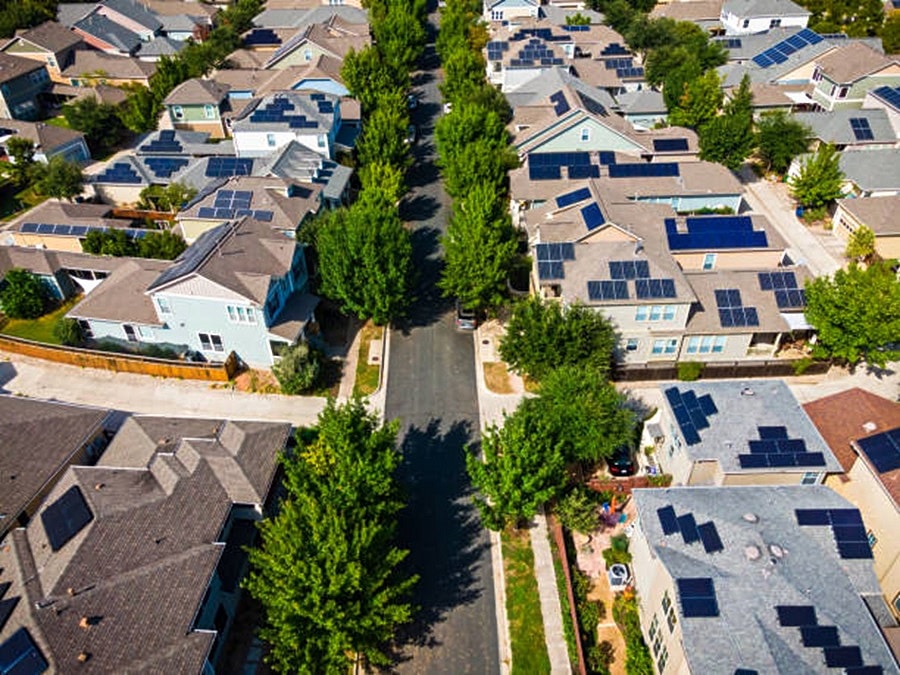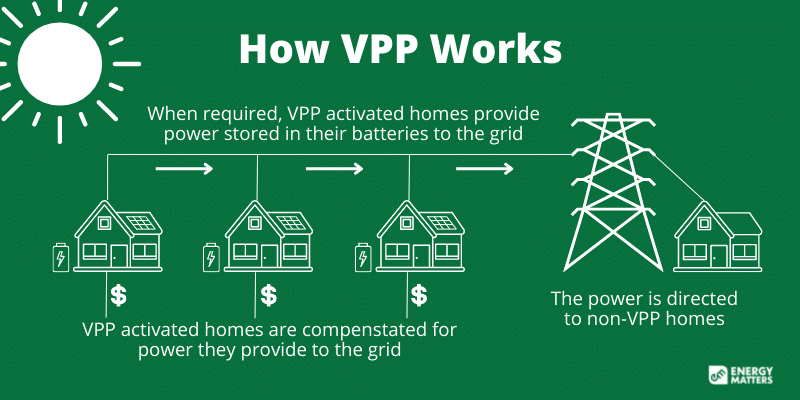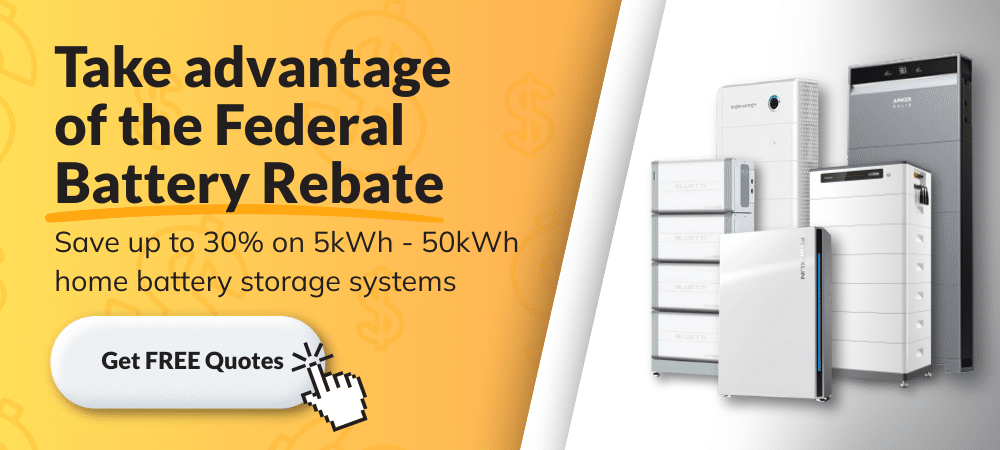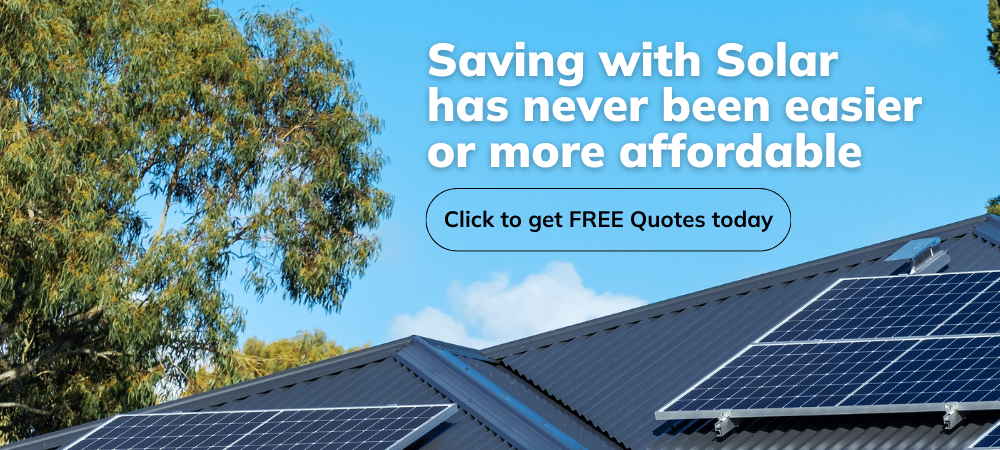A Virtual Power Plant, or VPP for short, is a network of connected solar batteries that can be coordinated like a pop-up power plant. VPPs allow renewable energy to be harnessed quickly, providing energy to the grid during times of peak demand. The result is a more stable, balanced network and reduced reliance on fossil fuels.
VPPs will play an important role in the future of Australia’s energy mix. The concept is win-win; VPP providers (aggregators and retailers) benefit from the flexibility and efficiency of a solar battery network, while participants can enjoy lower electricity bills and a shorter payback period on their solar and storage investment.

On this page
There are currently several VPP programs available in Australia, with more coming online over the year. Each VPP program offers its participants specific benefits, eligibility requirements, program structure and contract details.
To assist you in determining the best VPP for your home or business, you can use the below comparison table outlining the key features of the various VPP programs that are currently available in Australia.
Also, to aid in your exploration of VPP options, consider gaining valuable insights into solar energy by obtaining FREE solar quotes from Energy Matters, which facilitates an informed decision-making process for your home or business.
Current VPP programs available across Australia
The information in this table is current as of 03 March 2025. Updates will be made accordingly as more programs are developed and/or become available.
| VPP Program Name | Key Information |
| AGL BYO (Bring Your Own) Battery | AGL’s Virtual Power Plant shares the power of your current solar batteries and receives up to $280 in bill credits during the first 12 months. Additionally, you can qualify for $250–400 in incentives under the NSW PDRS Scheme for connecting your home to our Virtual Power Plant (VPP). To be eligible, customers need to have a compatible battery, such as Tesla, LG, or SolarEdge, and a smart meter. AGL’s VPP is available in NSW, QLD, SA, and VIC. |
| Amber for Batteries | Amber Electric offers an innovative approach to battery management, often discussed in the context of Virtual Power Plants (VPPs), although their model provides users with greater control than traditional VPPs. For a monthly subscription, Amber provides access to wholesale electricity prices and a sophisticated battery optimisation software called SmartShift™.
Eligibility criteria:
|
| Charge Force VPP by Powershop | Powershop offers a Virtual Power Plant (VPP) program in Australia called “Charge Force”, which allows eligible customers with solar and battery systems to participate by managing their energy usage to support the grid and potentially earn bill credits; this program is accessible in various states across Australia where Powershop operates. ‘Power credits’ are given to participants in addition to the solar feed-in tariff for battery discharge from VPP. Depending on the wholesale price, “power credits” are computed at a maximum rate of $6.95/kWh and a minimum fixed rate of 27.7c/kWh (SAPN only). |
| Discover Energy VPP Premium Plan | Discover Energy’s VPP program uses cloud-based software to monitor and control the customers’ inverters and batteries and provides a mobile app to track the trades and income statements. |
| Energy Australia “PowerResponse” | By participating in a VPP program, customers can earn rewards for sharing their excess energy or adjusting their consumption during peak periods. EnergyAustralia is one of Australia’s leading providers of VPP programs, offering attractive rates and incentives to its customers who own compatible solar and battery systems. |
| ENGIE New Battery VPP (Simply Energy New Battery VPP Offer) | After undergoing a transformation, Simply Energy is now ENGIE. Get a $500 sign-up credit on your electricity bill and earn approximately $20 monthly VPP credits—the longer you stay, the more you save! Additionally, maximise your solar exports with a competitive Feed-in Tariff.
To qualify, you must:
|
| ENGIE VPP BYO energy plan (Simply Energy BYO Battery VPP Offer) | As a new VPP customer, you’ll receive a $300 sign-up credit on your first bill, plus ongoing $20 monthly VPP community credits—the longer you stay, the more you earn! Additionally, benefit from a competitive solar Feed-in Tariff to make the most of your solar exports.
Eligibility requirements:
|
| Energy Australia “PowerResponse” | By participating in a VPP program, customers can earn rewards for sharing their excess energy or adjusting their consumption during peak periods. EnergyAustralia is one of Australia’s leading providers of VPP programs, offering attractive rates and incentives to its customers who own compatible solar and battery systems. |
| GloBird ZEROHERO | GloBird ZEROHERO is a VPP program offered by GloBird Energy, where you can earn credits by utilising your home battery during peak demand times. The Virtual Power Plant Terms and Conditions, the eligibility criteria, and all others must be met and maintained to receive VPP credits. Some of the key points about GloBird ZEROHERO:
|
| Nectr Evolve | Nectr’s VPP network manages the connected systems to optimise efficiency and reduce energy costs. Nectr offers several VPP plans to suit different energy needs, including:
|
| Origin Loop VPP | During Origin Loop events, you can receive a $200 sign-up incentive and $1/kWh* for energy that is taken from your battery and delivered to the grid. |
| Plico Energy VPP | Plico Energy offers a subscription-based solar power system for Western Australian homes and businesses. This system combines solar panels, batteries, and smart software to generate, store, and manage clean energy at an affordable weekly fee. It has zero upfront costs and 10 years of full service. Retrofit options are available for existing solar panels. |
| Reposit “No bill” | Reposit Power provides smart controllers for solar and battery systems and launched a No Bill™ plan that guarantees zero electricity bills for seven years. Customers who sign up for the plan will receive a Reposit Smart Controller, solar panels and batteries, which will be installed and monitored by Reposit. In exchange, Reposit will pay the customers’ electricity bills, including all fees, charges and taxes, as long as they stay within the terms and conditions of the plan. The No Bill™ plan is available for eligible households with approved batteries and inverters and requires customers to share their excess power with Reposit’s power-sharing community. |
| ShineHub VPP | ShineHub’s Virtual Power Plant (VPP) is available to customers in SA, VIC, NSW, and QLD with a compatible internet-connected battery. All batteries sold only through ShineHub’s online store (not BYO) are VPP-compatible, and new options are regularly added.
|
| SolarHub VPP (NSW Smart Distributed Batteries Project) | Through a customised energy plan called the Solar Partner Plus Plan, SolarHub chose ActewAGL as their VPP operator for this offer. Signing up for the VPP through the ActewAGL Solar Partner Plus Plan can help you take advantage of a fantastic deal that waives daily electricity supply prices and ensures a 17c FIT for the first 10kWh exported daily for a period of 12 months. Thanks to ActewAGL’s VPP, which interacts with it very little, your battery will never be discharged below 20%. The maximum amount the VPP can affect your electricity bill over 12 months is $50. Joining the VPP is a wise financial decision, especially considering the $4,950 discount and the advantages of the Solar Partner Plus Plan. |
| sonnenConnect | By installing solar panels and a sonnenBatterie with a capacity of 4kWh or more, customers can stay with their energy retailer, receive a feed-in tariff, and get a daily reward from sonnen when they help to stabilise the electricity grid. Eligible customers will also receive a $100 sign-up bonus (not available in NT or WA). You can join the sonnenCommunity and contribute to a clean energy future without any exit fees or lock-in contracts. To apply for sonnenConnect, you need to have a smart meter, and your sonnenBatterie must be connected to the National Electricity Market (ACT, NSW, QLD, SA, TAS or VIC). |
| sonnenFlat VPP | To be eligible, customers need a sonnenBatterie with a minimum usable capacity of 4kWh and a solar power system meeting the minimum annual generation requirement. Depending on the size of the solar installation and the battery, customers can choose from different plans that include an annual household usage allowance and an annual export threshold. Customers who exceed their usage allowance will pay an excess usage rate, while customers who export more than their threshold will receive a solar feed-in rate. sonnenFlat covers network supply charges and has no lock-in contracts or contract terms. Read more about sonnenFlat Electricity Power Packages. |
| Tesla Energy Plan/Energy Locals | By signing up to the Tesla Energy Plan, you can enjoy competitive energy rates, Grid Support Credits, Powerwall Credits, and an extended warranty on your Powerwall. To be eligible, you need to have or purchase a Powerwall, a smart meter, an internet connection, and a solar power system under 15 kW per Powerwall. Tesla’s technology optimises the use of your Powerwall based on your energy needs, market conditions, weather and anticipated grid events. |
| WATTBANK VPP by Diamond Energy | WATTBANK VPP is offered by Diamond Energy, an Australian renewable energy company, allowing customers to participate in a network of solar and battery systems to manage and share renewable energy on the grid. LAVO EAAS by Diamond Energy In particular, Diamond Energy’s “WATTBANK VPP” programme, which enables users with LAVO solar and battery systems to take part by supplying stored energy to the grid during periods of peak demand and possibly earning credits for doing so, qualifies as a Virtual Power Plant (VPP) in the Australian market. |
VPP Programs Victoria (VIC)
- AGL “Bring Your Own Battery”
- Amber for Batteries
- Charge Force VPP by Powershop
- Discover Energy VPP
- Energy Australia “PowerResponse”
- ENGIE New Battery VPP
- ENGIE BYO Battery VPP
- Globird ZEROHERO
- Nectr Evolve VPP
- Origin Loop Virtual Power Plant (within 50km of Melbourne CBD)
- Reposit “No bill”
- ShineHub
- sonnenConnect
- sonnenFlat VPP
- Tesla Energy Plan/Energy Locals
- WATTBANK VPP by Diamond Energy
Solar Victoria Virtual Power Plant (VPP) Pilot Program
Households who install an approved battery and sign up to one of six participating VPP programs before July 2022 will receive a higher Solar Homes Program rebate at a fixed rate of $4,174 (as opposed to a maximum $3,500 for non-VPP rebates).
The government-backed program is capped at 2000 rebates and is limited to five approved battery providers; Tesla, Mondo, Reposit, Sonnen and Arcstream.
More information on the program can be found here.
VPP Programs New South Wales (NSW)
- AGL “Bring Your Own Battery”
- Amber for Batteries
- Charge Force VPP by Powershop
- Discover Energy VPP
- Energy Australia “PowerResponse”
- ENGIE New Battery VPP
- ENGIE BYO Battery VPP
- Globird ZEROHERO
- Origin Loop Virtual Power Plant (within 50km of Sydney CBD)
- Reposit “No bill”
- ShineHub
- sonnenConnect
- sonnenFlat VPP
- Tesla Energy Plan/Energy Locals
- WATTBANK VPP by Diamond Energy
NSW Government Virtual Power Plant (VPP)
The NSW VPP battery incentive will increase. When you connect your battery to a participating Virtual Power Plant, you will be eligible for a one-off payment based on the battery size from 1 July 2025.
- Up to $550 for a 10 kWh battery,
- Up to $1,500 for a 27 kWh battery.
Your exact incentive payout will vary based on several criteria, including:
- The provider of the virtual power plants you select
- The agreement you sign with your Virtual Power Plant provider outlines the terms of your collaboration. This can include when the Virtual Power Plant can access your battery and how much you are paid for your excess electricity.
VPP Programs Queensland (QLD)
- AGL “Bring Your Own Battery”
- Amber for Batteries (SE QLD only)
- Charge Force VPP by Powershop (SE QLD only)
- Discover Energy VPP (SE QLD only)
- Energy Australia “PowerResponse”
- ENGIE New Battery VPP
- ENGIE BYO Battery VPP
- Globird ZEROHERO (Energex region only)
- Origin Loop Virtual Power Plant (within 50km of Brisbane CBD or Gold Coast metro)
- Reposit “No bill”
- ShineHub
- sonnenConnect
- sonnenFlat VPP
- Tesla Energy Plan/Energy Locals (SE QLD only)
- WATTBANK VPP by Diamond Energy (Energex region only)
VPP Programs South Australia (SA)
- AGL “Bring Your Own Battery”
- Amber for Batteries
- Discover Energy VPP
- Energy Australia “PowerResponse”
- ENGIE New Battery VPP
- ENGIE BYO Battery VPP
- Globird ZEROHERO
- Reposit “No bill”
- South Australia’s Virtual Power Plant (SA VPP)
- ShineHub
- sonnenConnect
- sonnenFlat VPP
- Tesla Energy Plan/Energy Locals
- WATTBANK VPP by Diamond Energy
South Australia’s Virtual Power Plant (SA VPP)
South Australia’s Virtual Power Plant (SA VPP) is a pioneering initiative launched in 2018, aiming to aggregate up to 50,000 homes equipped with solar panels and Tesla Powerwall batteries into a cohesive, decentralised energy network. As of late 2024, approximately 7,000 households are participating, contributing a combined capacity of 35 MW.
Eligibility criteria:
- Housing SA tenants: Eligible tenants are offered free installation and maintenance of solar and battery systems.
- Private homeowners: Residents owning their homes can join by enrolling in the Tesla Energy Plan, which requires ownership of a Tesla Powerwall and a compatible solar system.
- Community housing residents: Tesla and housing providers may collaborate to invite tenants in community housing to participate.
VPP Programs Western Australia (WA)
- Plico Energy VPP
- Reposit “No bill”
- sonnenFlat VPP
VPP Programs Australian Capital Territory (ACT)
- Amber for Batteries
- SolarHub VPP
- Discover Energy VPP
- Energy Australia “PowerResponse”
- Reposit “No bill”
- sonnenConnect
- sonnenFlat VPP
- Tesla Energy Plan/Energy Locals
VPP Programs Tasmania (TAS)
- Energy Australia “PowerResponse”
- Members Energy
- PowerClub Powerbank
- Reposit “No bill”
- sonnenConnect
- sonnenFlat VPP
Harnessing the sun's power: How VPPs revolutionise Australia's home solar
Imagine thousands of homes across Australia, each equipped with a gleaming solar power system, not just generating clean energy for themselves, but working together as one giant virtual power plant (VPP). That’s the exciting reality of VPPs in Australia, transforming how we think about home solar.
Here’s how it works: When you install solar panels on your roof, your home becomes a mini power station. Any excess energy you generate is usually exported back to the grid, often at a low feed-in tariff. But with a VPP, your home solar system joins a network of other solar-powered homes. A central platform monitors and coordinates this network, strategically drawing on your stored solar power at peak times when the grid needs it most. This can happen during solar installation, or even later through a solar panel installation company that offers VPP services. Read more about How a Virtual Power Plant (VPP) Works.

The benefits are multifold. For you, it means earning more for your solar power and potentially even reducing your electricity bills. VPPs provide backup and stability for the grid, especially during hot summer days when rooftop solar generation dips. And for Australia, it’s a giant leap towards a cleaner, more resilient energy future.
So, if you’re considering solar panel installs or already have a home solar system, look into VPPs. It’s a win-win for you, the grid, and the planet. Let’s harness the sun’s power together, one rooftop at a time!
Our professional solar installers will assess and determine your energy needs. We customise a solar panel system to fit the roof size of your property, ensuring you receive the most suitable solar panel system for your home, and meeting the property’s energy requirements.
Find out more information about solar across Australia:
Solar Panels Brisbane, Solar Panels Melbourne, Solar Panels Sydney, Best Solar Panels Canberra, Reputable Solar Companies Perth, Solar Panels Darwin, Solar Panels Hobart, and Solar Panels Adelaide.









































